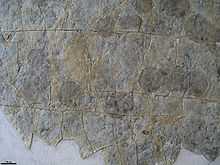Epibaion
From Wikipedia, the free encyclopedia
| Epibaion Temporal range: Ediacaran, around 558–555Ma | |
|---|---|
| Trace fossil classification | |
| Ichnogenus: | †Epibaion Ivantsov, 2002 |
| Ichnospecies | |
| |

Epibaion waggoneris, chain of trace platforms and the imprint of the body of Yorgia waggoneri (right), which created these traces.
References
- ↑ Ivantsov, A.Y.; Malakhovskaya, Y.E. (2002). "Giant Traces of Vendian Animals". Doklady Earth Sciences 385 (6): 618–622.
- ↑ Ivantsov, A. Y. (2011). "Feeding traces of Proarticulata — the Vendian metazoa". Paleontological Journal 45 (3): 237–248. doi:10.1134/S0031030111030063.
- ↑ Andrey Yu. Ivantsov (2013). "Trace Fossils of Precambrian Metazoans "Vendobionta" and "Mollusks"". Stratigraphy and Geological Correlation 21 (3): 252–264. doi:10.1134/S0869593813030039.
This article is issued from Wikipedia. The text is available under the Creative Commons Attribution/Share Alike; additional terms may apply for the media files.